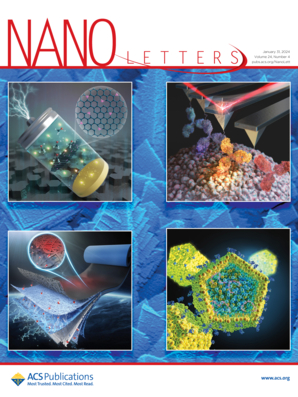Enhancing the Self-Healing Efficiency of Ti3AlC2 MAX Phase via Irradiation
IF 9.6
1区 材料科学
Q1 CHEMISTRY, MULTIDISCIPLINARY
引用次数: 0
Abstract
Self-healing materials are highly desirable in the nuclear industry to ensure nuclear security. Although extensive efforts have been devoted to developing self-healing materials in the past half century, very limited successes have been reported for ceramics or metals. Here, we report an intrinsic self-healing material of Ti3AlC2 MAX phase, which exhibits both ceramic and metallic properties, and a strategy for further enhancing the self-healing via irradiation is proposed. Quantitative in situ transmission electron microscopy tensile testing reveals that the fracture strength of 1.58 GPa is achieved on thoroughly fractured Ti3AlC2, corresponding to the self-healing efficiency of 19.8%, which is increased to 28.1% after irradiation. In situ irradiation experiments, atomic-resolution characterizations, and molecular dynamics simulations reveal that spontaneous rebonding of partial atoms on fracture surfaces is responsible for the self-healing, and irradiation-enhanced atomic migration, interplanar spacing increment, and gap-filling contribute to the self-healing enhancement.

通过辐照提高 Ti3AlC2 MAX 相的自愈效率
为确保核安全,核工业非常需要自愈材料。尽管在过去的半个世纪里,人们一直致力于开发自愈合材料,但陶瓷或金属材料的成功报道非常有限。在此,我们报告了一种兼具陶瓷和金属特性的 Ti3AlC2 MAX 相本征自愈合材料,并提出了通过辐照进一步增强自愈合的策略。原位透射电子显微镜定量拉伸测试表明,彻底断裂的 Ti3AlC2 可达到 1.58 GPa 的断裂强度,自愈合效率为 19.8%,辐照后提高到 28.1%。原位辐照实验、原子分辨率表征和分子动力学模拟揭示了断裂表面部分原子的自发再结合是自愈合的原因,而辐照增强的原子迁移、平面间距增大和间隙填充则是自愈合增强的原因。
本文章由计算机程序翻译,如有差异,请以英文原文为准。
求助全文
约1分钟内获得全文
求助全文
来源期刊

Nano Letters
工程技术-材料科学:综合
CiteScore
16.80
自引率
2.80%
发文量
1182
审稿时长
1.4 months
期刊介绍:
Nano Letters serves as a dynamic platform for promptly disseminating original results in fundamental, applied, and emerging research across all facets of nanoscience and nanotechnology. A pivotal criterion for inclusion within Nano Letters is the convergence of at least two different areas or disciplines, ensuring a rich interdisciplinary scope. The journal is dedicated to fostering exploration in diverse areas, including:
- Experimental and theoretical findings on physical, chemical, and biological phenomena at the nanoscale
- Synthesis, characterization, and processing of organic, inorganic, polymer, and hybrid nanomaterials through physical, chemical, and biological methodologies
- Modeling and simulation of synthetic, assembly, and interaction processes
- Realization of integrated nanostructures and nano-engineered devices exhibiting advanced performance
- Applications of nanoscale materials in living and environmental systems
Nano Letters is committed to advancing and showcasing groundbreaking research that intersects various domains, fostering innovation and collaboration in the ever-evolving field of nanoscience and nanotechnology.
 求助内容:
求助内容: 应助结果提醒方式:
应助结果提醒方式:


